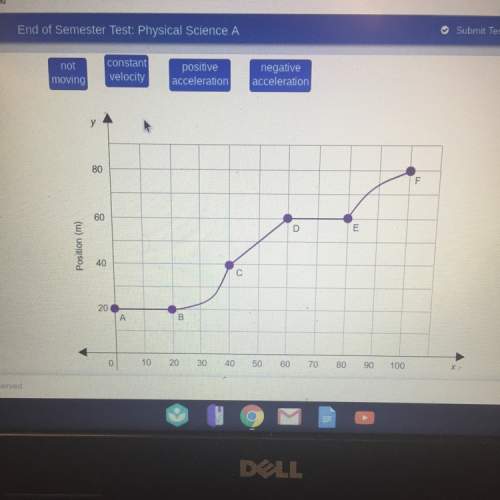
Physics, 26.11.2019 18:31 crystalrc3414
You have a glass ball with a radius of 2.00 mm and a density of 2500 kg/m3. you hold the ball so it is fully submerged, just below the surface, in a tall cylinder full of glycerin, and then release the ball from rest. take the viscosity of glycerin to be 1.5 pa s and the density of glycerin to be 1250 kg/m3. use g = 10 n/kg = 10 m/s2. also, note that the drag force on a ball moving through a fluid is: fdrag = 6πηrv .(a) note that initially the ball is at rest. sketch (to scale) the free-body diagram of the ball just after it is released, while its velocity is negligible.(b) calculate the magnitude of the ball’s initial acceleration.(c) eventually, the ball reaches a terminal (constant) velocity. sketch (to scale) the free-body diagram of the ball when it is moving at its terminal velocity.(d) calculate the magnitude of the terminal velocity.(e) what is the magnitude of the ball’s acceleration, when the ball reaches terminal velocity? (f) let’s say that the force of gravity acting on the ball is 4f, directed down. we can then express all the forces in terms of f. (for instance, you might label a force on a free-body diagram as "fdrag = 3f".) sketch three free-body diagrams, and express all forces in terms of f. hint: do the middle one last. initial fbd fbd for when v = half fbd for when (when released from rest) the terminal velocity v = terminal velocity(g) how does the net force in the left-most free-body diagram compare to that in the middle free-body diagram? combine that information with your result from problem 1, regarding the initial acceleration, to find the magnitude of the acceleration when the ball’s speed is half the terminal speed.(h) take down to be positive for all your graphs. (i) sketch a grapch of the ball’s acceleration as a function of time; (ii) sketch a graph of the ball’s velocity as a function of time; (iii) sketch a graph of the ball’s position as a function of time. if you can be quantitative with your axis labels, then do so.

Answers: 1


Another question on Physics

Physics, 21.06.2019 16:30
How do hydroponic plants differ from nonhydroponic plants? a.) hydroponic plants can grow in a dryer soil. nonhydroponic plants grow in moist soil. b.) hydroponic plants grow on other plants and are known as air plants. nonhydroponic plants do not grow on other plants. c.) hydroponic plants can only grow in rain forests. nonhydroponic plants cannot grow in rain forests. d.) hydroponic plants are grown without soil. nonhydroponic plants are grown in soil.
Answers: 2

Physics, 22.06.2019 05:50
There are two routes similar in terrain; however, one route has an incline of approximately 28 degrees, and you must decide on which route to take. what is the maximum road grade that your fully loaded ecv can climb?
Answers: 2

Physics, 22.06.2019 15:20
Acarpenter builds an exterior house wall with a layer of wood 2.9 cm thick on the outside and a layer of styrofoam insulation 2.3 cm thick on the inside wall surface. the wood has k=0.080w/(m⋅k), and the styrofoam has k= 0.010 w/(m⋅k). the interior surface temperature is 19.0 ∘c , and the exterior surface temperature is -15.0 ∘c . a.)what is the temperature at the plane where the wood meets the styrofoam? celsius b.)what is the rate of heat flow per square meter through this wall? /m^2
Answers: 2

Physics, 22.06.2019 18:00
Sunidhi made a study chart about changes in states of matter. which headings best complete the chart?
Answers: 1
You know the right answer?
You have a glass ball with a radius of 2.00 mm and a density of 2500 kg/m3. you hold the ball so it...
Questions

History, 12.07.2019 13:50

Social Studies, 12.07.2019 13:50


Chemistry, 12.07.2019 13:50

History, 12.07.2019 13:50

Mathematics, 12.07.2019 13:50


Social Studies, 12.07.2019 13:50

Mathematics, 12.07.2019 13:50

Mathematics, 12.07.2019 13:50



History, 12.07.2019 13:50

Social Studies, 12.07.2019 13:50


Chemistry, 12.07.2019 13:50

Mathematics, 12.07.2019 13:50

Social Studies, 12.07.2019 13:50

Social Studies, 12.07.2019 13:50

Social Studies, 12.07.2019 13:50




